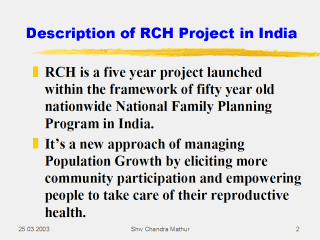
It’s a project to
improve the quality of reproductive health services delivered from public facilities. It
entails the creation of more peripheral facilities on one hand and rejuvenating the
existing facilities by providing major inputs like trained manpower and requisite
equipment's on the other.
This project of Government
of India has a major funding support from World Bank. The other agencies supporting the
Project include UNFPA, Unicef , European Commission, DFID and SIDA.
|
The
first census (1951) in post-independence era revealed India’s Population to be 330
million which by 1991 reached to 840 million and more than one billion by 2001. India is
the second largest population of the world. In approximately 2.5 percent of landmass, 15
percent of the world's population inhabits in India. After signing the MOU at ICPD, Cairo
in 1994, Government of India has made critical changes in its managerial approach towards
population control. This lecture documents the success and failure in managing the
paradigm shift in India’s Family Planning Program . |
